List of moments of inertia
In physics and applied mathematics, the mass moment of inertia, usually denoted by I, measures the extent to which an object resists rotational acceleration about a particular axis, and is the rotational analogue to mass. Mass moments of inertia have units of dimension ML2([mass] × [length]2). It should not be confused with the second moment of area, which is used in bending calculations. The mass moment of inertia is often also known as the rotational inertia, and sometimes as the angular mass.
For simple objects with geometric symmetry, one can often determine the moment of inertia in an exact closed-form expression. Typically this occurs when the mass density is constant, but in some cases the density can vary throughout the object as well. In general, it may not be straightforward to symbolically express the moment of inertia of shapes with more complicated mass distributions and lacking symmetry. When calculating moments of inertia, it is useful to remember that it is an additive function and exploit the parallel axis and perpendicular axis theorems.
This article mainly considers symmetric mass distributions, with constant density throughout the object, and the axis of rotation is taken to be through the center of mass unless otherwise specified.
Moments of inertia
Following are scalar moments of inertia. In general, the moment of inertia is a tensor, see below.
| Description | Figure | Moment(s) of inertia |
|---|---|---|
| Point mass m at a distance r from the axis of rotation.
A point mass does not have a moment of inertia around its own axis, but using the parallel axis theorem a moment of inertia around a distant axis of rotation is achieved. |
 |
|
| Two point masses, M and m, with reduced mass μ and separated by a distance, x about an axis passing through the center of mass of the system and perpendicular to line joining the two particles. | ||
| Rod of length L and mass m, rotating about its center.
This expression assumes that the rod is an infinitely thin (but rigid) wire. This is a special case of the thin rectangular plate with axis of rotation at the center of the plate, with w = L and h = 0. |
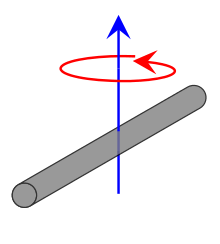 |
[1] |
| Rod of length L and mass m, rotating about one end.
This expression assumes that the rod is an infinitely thin (but rigid) wire. This is also a special case of the thin rectangular plate with axis of rotation at the end of the plate, with h = L and w = 0. |
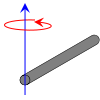 |
[1] |
| Thin circular hoop of radius r and mass m.
This is a special case of a torus for b = 0 (see below), as well as of a thick-walled cylindrical tube with open ends, with r1 = r2 and h = 0. |
 |
|
| Thin, solid disk of radius r and mass m.
This is a special case of the solid cylinder, with h = 0. That is a consequence of the perpendicular axis theorem. |
 |
|
| Thin cylindrical shell with open ends, of radius r and mass m.
This expression assumes that the shell thickness is negligible. It is a special case of the thick-walled cylindrical tube for r1 = r2. Also, a point mass m at the end of a rod of length r has this same moment of inertia and the value r is called the radius of gyration. |
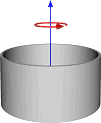 |
[1] |
| Solid cylinder of radius r, height h and mass m.
This is a special case of the thick-walled cylindrical tube, with r1 = 0. (Note: X-Y axis should be swapped for a standard right handed frame). |
 |
[1] |
| Thick-walled cylindrical tube with open ends, of inner radius r1, outer radius r2, length h and mass m. |  |
[1]
[2]
|
| With a density of ρ and the same geometry | | |
| Regular tetrahedron of side s and mass m | 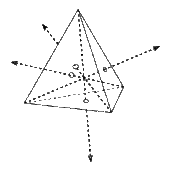 |
|
| Regular octahedron of side s and mass m | 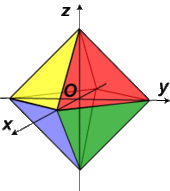 |
[3] [3] |
| Regular dodecahedron of side s and mass m |
(where ) [3] | |
| Regular icosahedron of side s and mass m | ||
| Hollow sphere of radius r and mass m.
A hollow sphere can be taken to be made up of two stacks of infinitesimally thin, circular hoops, where the radius differs from 0 to r (or a single stack, where the radius differs from -r to r). |
 |
[1] |
| Solid sphere (ball) of radius r and mass m.
A sphere can be taken to be made up of two stacks of infinitesimally thin, solid discs, where the radius differs from 0 to r (or a single stack, where the radius differs from -r to r). |
 |
[1] |
| Sphere (shell) of radius r2, with centered spherical cavity of radius r1 and mass m.
When the cavity radius r1 = 0, the object is a solid ball (above). When r1 = r2, , and the object is a hollow sphere. |
 |
[1] |
| Right circular cone with radius r, height h and mass m |  |
[4] [4] |
| Torus with minor radius a, major radius b and mass m. | .png) |
About an axis passing through the center and perpendicular to the diameter: [5] About a diameter: [5] |
| Ellipsoid (solid) of semiaxes a, b, and c with mass m | 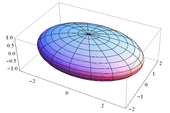 |
|
| Thin rectangular plate of height h, width w and mass m (Axis of rotation at the end of the plate) |
 |
|
| Thin rectangular plate of height h, width w and mass m (Axis of rotation at the center) |
 |
[1] |
| Solid cuboid of height h, width w, and depth d, and mass m.
For a similarly oriented cube with sides of length , |
 |
|
| Solid cuboid of height D, width W, and length L, and mass m, rotating about the longest diagonal.
For a cube with sides , . |
 |
|
| Triangle with vertices at the origin and at P and Q, with mass m, rotating about an axis perpendicular to the plane and passing through the origin. | ||
| Plane polygon with vertices P1, P2, P3, ..., PN and mass m uniformly distributed on its interior, rotating about an axis perpendicular to the plane and passing through the origin. |  |
|
| Plane regular polygon with n-vertices and mass m uniformly distributed on its interior, rotating about an axis perpendicular to the plane and passing through the origin. a stands for side length. | [6] | |
| Infinite disk with mass normally distributed on two axes around the axis of rotation with mass-density as a function of x and y:
|
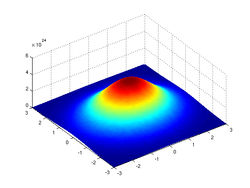 |
|
| Uniform disk about an axis perpendicular to its edge. | [7] |
List of 3D inertia tensors
This list of moment of inertia tensors is given for principal axes of each object.
To obtain the scalar moments of inertia I above, the tensor moment of inertia I is projected along some axis defined by a unit vector n according to the formula:
where the dots indicate tensor contraction and we have used the Einstein summation convention. In the above table, n would be the unit Cartesian basis ex, ey, ez to obtain Ix, Iy, Iz respectively.
| Description | Figure | Moment of inertia tensor |
|---|---|---|
| Solid sphere of radius r and mass m |  |
|
| Hollow sphere of radius r and mass m |  |
|
| Solid ellipsoid of semi-axes a, b, c and mass m | 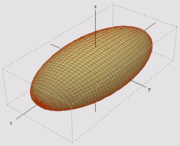 |
|
| Right circular cone with radius r, height h and mass m, about the apex |  |
|
| Solid cuboid of width w, height h, depth d, and mass m |  |
|
| Slender rod along y-axis of length l and mass m about end |  |
|
| Slender rod along y-axis of length l and mass m about center |  |
|
| Solid cylinder of radius r, height h and mass m |  |
|
| Thick-walled cylindrical tube with open ends, of inner radius r1, outer radius r2, length h and mass m |  |
|
See also
- Parallel axis theorem
- Perpendicular axis theorem
- List of second moments of area
- The inertia tensor of a triangle in three-dimensional space
References
- 1 2 3 4 5 6 7 8 9 Raymond A. Serway (1986). Physics for Scientists and Engineers, second ed. Saunders College Publishing. p. 202. ISBN 0-03-004534-7.
- ↑ Classical Mechanics - Moment of inertia of a uniform hollow cylinder. LivePhysics.com. Retrieved on 2008-01-31.
- 1 2 3 4 5 Satterly, John (1958). "The Moments of Inertia of Some Polyhedra". The Mathematical Gazette. Mathematical Association. 42 (339): 11–13. doi:10.2307/3608345. JSTOR 3608345.
- 1 2 Ferdinand P. Beer and E. Russell Johnston, Jr (1984). Vector Mechanics for Engineers, fourth ed. McGraw-Hill. p. 911. ISBN 0-07-004389-2.
- 1 2 Eric W. Weisstein. "Moment of Inertia — Ring". Wolfram Research. Retrieved 2010-03-25.
- ↑ Karel Rektorys (1994). Survey of Applicable Mathematics, second ed., Vol. II. Kluwer Academic Publisher. p. 942. ISBN 0-7923-0681-3.
- ↑ http://www.pas.rochester.edu/~ygao/phy141/Lecture15/sld010.htm